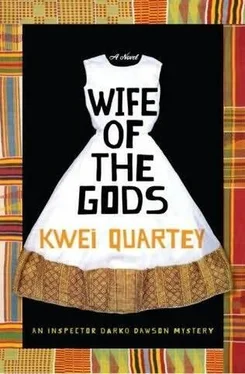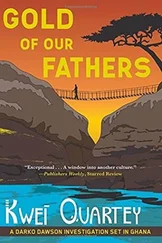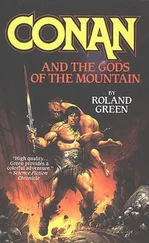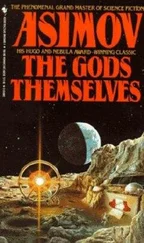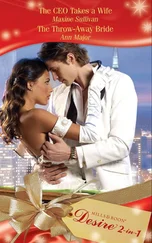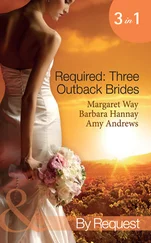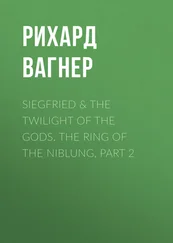It was past eleven o’clock in the morning, and a dense crowd of funeral spectators and mourners had collected at the Mensahs’ home. Dawson parked away from the house, closer to Elizabeth’s dress shop.
A dancing and drumming troupe was performing in a courtyard at the side of the house. The collective driving beat of the sogo, kidi , and atsimevu drums was irresistible. A young woman came out and began dancing the Agbadza, her arms rotating rhythmically from her shoulders while her torso swung back and forth in opposing motion. Another two women soon joined, and then a man. They kicked up red dust with their steps.
Dawson saw someone handing out beer to several men at the back of the crowd. Freeloaders . They would be thoroughly drunk by early afternoon.
For the short funeral service, a seating area under a canopy had been set up in front of the Mensahs’ house. There was a long line of people waiting to get inside to view Gladys’s body. Dawson wormed his way to the front and went in. It was packed with people in a sea of black and dark brown mourning cloth. It was oppressive, and Dawson was bothered by the tight space. Gladys lay in state in the front room. The men stood back, but several women were wailing loudly over her casket while the procession of viewers slowly wound its way past her body. In the midst of all this was a videographer filming everything, and a few people were snapping photos of Gladys’s body with their mobile phones and digital cameras, which Dawson found quite bizarre.
A woman in red and black had worked herself into quite a state, sweat pouring off her as if she had been in a rain shower. She was weeping and moving frenetically around the casket like a roaming insect.
“Why have you left us?” she shouted hoarsely, gesticulating at Gladys’s body. “What will we do now?”
Dawson wondered for a moment if she was a professional mourner. Families sometimes hired these, but he doubted the Mensahs would do that.
Gladys had been dressed in iridescent blue and her casket supplied with items she might need for her journey to the other side: makeup, perfume, jewelry, and a large roll of yellow and white fabric embellished with Adinkra symbols. In case she needed a change of outfit, Dawson supposed.
Everyone who entered the room was obligated to pay their respects to Kofi and Dorcas Mensah and the extended family. There was no way for Dawson to avoid it. He had no idea who 99 percent of these people were, but he had to shake hands with every single one of them. After a while he stopped counting.
He stood near Gladys’s casket for a moment. She had been heavily made up, and Dawson felt disturbed by that. A dead body at a crime scene or in the morgue meant something to him, but a decorated corpse in a casket left him cold. Gladys’s body was a shell. The whole person was gone, and no amount of makeup could bring her back. Feeling suffocated by the atmosphere, Dawson went outside to watch the dancing.
A new set of dancers was performing to distorted music blaring from a pair of speakers.
“Did you get some refreshments?”
He turned at the voice. “Hello, Elizabeth. No, I didn’t have anything to drink.”
She was dressed in a beautiful burgundy wax print with black velvet trim. She raised her voice above the din and beckoned to a boy a few meters away.
“Would you like some beer?” she asked Dawson.
“No thanks. How about some Malta?”
“Go and bring a bottle of Malta for him,” Elizabeth commanded the boy.
He obediently ran off.
She smiled at Dawson. “Are you all right? I saw you in the wake room, and you seemed uncomfortable.”
“I don’t do well at these kinds of things.”
“Sometimes it gets too much,” she acknowledged. “But traditions die hard.”
“Do you believe in all of it? Putting things in the casket, for instance?”
“It’s symbolic, that’s all. It means we care about her even to the point of her leaving us. Providing her with the things she liked.”
Something suddenly occurred to Dawson. “The cloth in the casket with the little Adinkra symbols-is that the yellow version of the blue one she was wearing?”
“Yes, that’s right,” Elizabeth said. “She loved that pattern, Inspector Dawson. She had a yellow, a blue, and a red. We didn’t want to put the blue one with her, so we chose the yellow because it’s so nice and bright.”
The boy came back with a bottle of half-chilled Malta, and Dawson thanked him. He took a couple of swigs.
“Elizabeth, I want you to do something for me,” Dawson said, raising his voice above the noise. “Can we go over there where it’s quieter?”
They walked a distance until the music was less intense.
“That’s better,” Dawson said. “I’m going to show you a diagram someone drew of what might be Gladys’s missing bracelet. Tell me if you think it looks like hers. Take your time. Don’t hurry to any conclusion.”
He took Nunana’s diagram from his pocket and gave it to Elizabeth. While she looked at it, he downed some more Malta, Heaven’s elixir.
“It had two rows of silver loops the way it’s drawn here,” Elizabeth said, tapping the paper with a manicured index finger. “It could be it. Who did this? Where did you get it?”
“I can’t say right now,” Dawson answered evenly. “Tell me this, if I stole a bracelet like this and I wanted to sell it quickly, where would I go?”
“The best place would be to one of the jewelry traders at the Ho market.”
“Would they buy one like this?”
Elizabeth nodded vigorously. “By all means, because the traders know how to shine it up and then sell it at a profit.”
“How many jewelry traders come to the Ho market?”
“Lots of them. I know a few. I can take you there after the funeral is over.”
“Thank you.”
“I have to go now,” Elizabeth said. “They’re going to close the casket, and then the service will start. Would you like to come?”
“I’ll be all right here, thank you.”
After some time the casket was brought out. Dawson watched the service from a distance. It was performed in both English and Ewe, using a microphone so people could listen if they weren’t in the seating area. It was hot even under the canopy, and people were fanning themselves somewhat uselessly with the funeral program. Older men wore the traditional style mourning cloth, while the young could not be bothered and dressed in shirts and slacks, some quite casually.
The service lasted forty-five minutes and went like clockwork. Finally, the pallbearers raised the coffin and a chorus of women began to sing and clap. An elderly woman with bare shoulders led the procession, pouring libation along the way. They would walk a short distance through Ketanu to the hearse that would take the coffin to the cemetery.
Dawson realized they were heading in the direction of his car, so he hurried to the Corolla and backed it well out of the way beside Elizabeth’s shop. He leaned against the trunk and watched as the long line of black-clad marchers moved forward like a giant millipede.
Just before the pallbearers passed the shop, the coffin seemed to veer off course. It was as though a magnet was attracting it, but then Dawson realized that two or more of the pallbearers were deliberately pulling the coffin to one side. He couldn’t understand what was going on. Some of the men lost their balance, and the coffin tilted and pitched. Cries of alarm went up: Don’t drop the coffin!
An older man stumbled and screamed, “What are you doing? Heh! What are you doing?”
Several funeral attendees ran in to help steady the coffin as a pushing and pulling match began. Members of the crowd began to shout and jeer, but then another cry gradually became prominent as a collective chant.
Читать дальше
